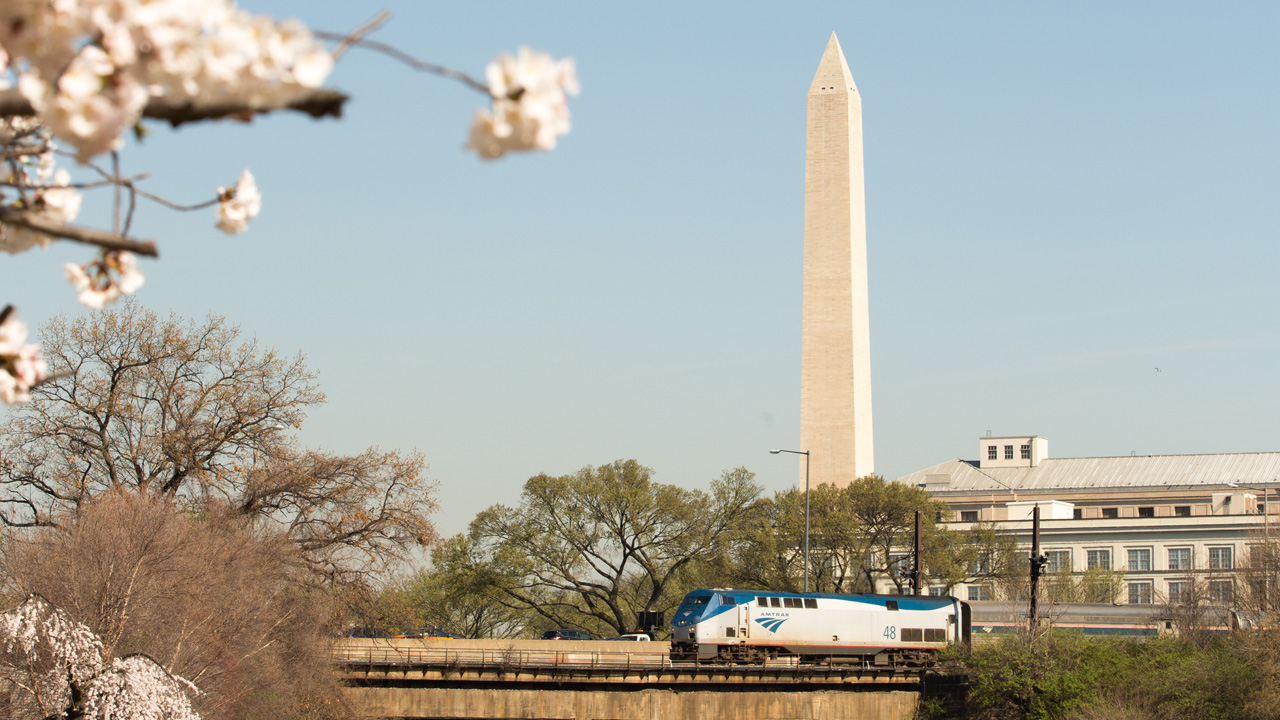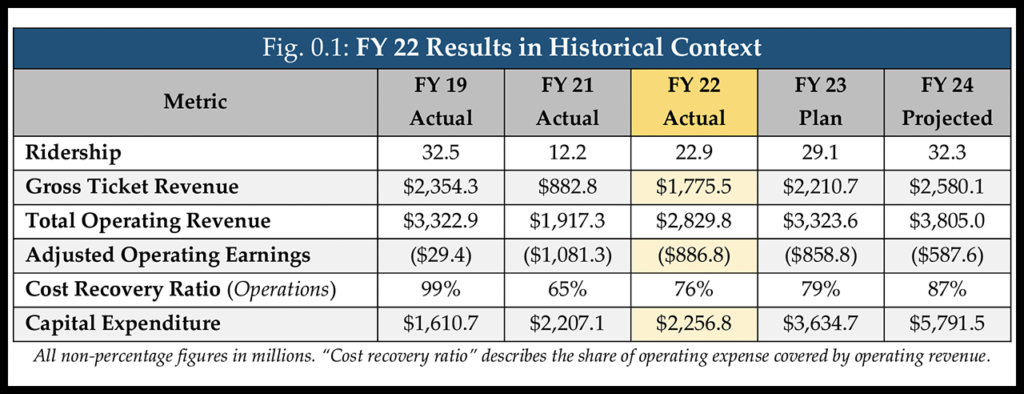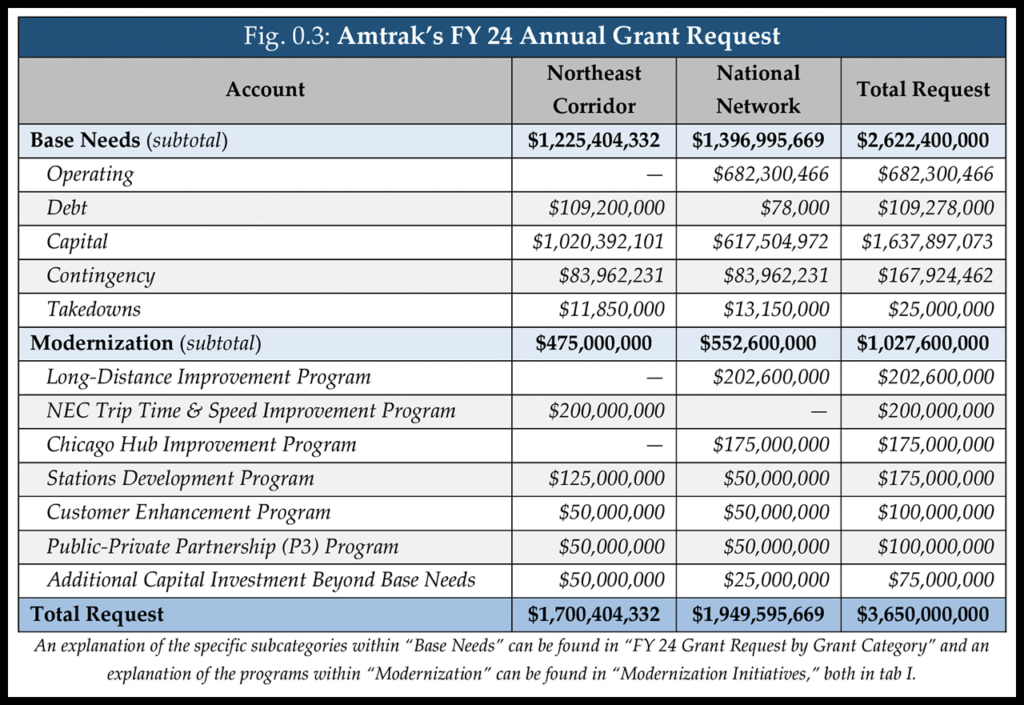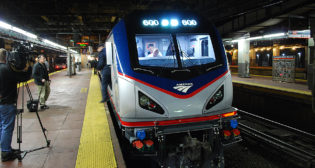
Amtrak Releases G&L Annual Report, FY24 Grant Request
Written by Marybeth Luczak, Executive Editor
(Amtrak Photograph)
Amtrak has issued its Fiscal Year (FY) 2024 General and Legislative (G&L) Annual Report for Congress, in which it seeks $3.65 billion in total grant funding, including $1.70 billion for the Northeast Corridor (NEC) and $1.95 billion for the National Network (NN). This is consistent with the FY24 annual appropriations authorized under the Infrastructure Investment and Jobs Act (IIJA).
“Thanks to the support of Congress and the enactment of the Infrastructure Investment and Jobs Act (IIJA), Amtrak has now begun a new era of investment to improve our service to communities across the nation and to expand our network to serve more people with more trains in markets where intercity passenger rail can make a difference ,” Amtrak CEO Stephen Gardner wrote in the 129-page report’s introduction (download below). “Through modern infrastructure, new fleets of trains, upgraded technology, and a new generation of dedicated employees, Amtrak is committed to delivering reliable, high-quality, and modern services to the tens of millions of Americans who ride our trains and on behalf of the various federal and state partners that support in serving the traveling public.”
In the report, Gardner noted that Amtrak’s overall financial performance in FY22 “improved significantly, continuing our trend of recovery since the COVID-19 pandemic.” Total ridership came in at 22.9 million—71% of FY19 levels—and the railroad’s adjusted operating earnings “exceeded our estimates, led notably by a nearly 50% growth in revenue compared to FY21 as our strategy of attracting new riders, aggressively managing sales and pricing, and broadening our customer base produced results,” he explained.

Despite this, ridership and operating revenues were “outmatched by the strong headwinds of rising costs, which meant substantial operating losses remained,” Gardner reported. “In particular, operating costs increased as we returned services across our network while high-value Northeast Corridor (NEC) business travel was slow to recover, which had an outsized effect on our revenues.” Additionally, Gardner said, “to support a historic increase in the number and size of capital projects now being advanced with IIJA funding, the company began a multi-year increase in investments associated with hiring and training, financial controls, and other company-wide needs, which is adversely impacting our adjusted operating earnings.” He said this was on top of “general inflationary pressures that adversely affected many aspects of Amtrak’s business in FY22: the company’s costs per available seat-mile rose by more than 15% from FY19 levels.”
Gardner also reported that Amtrak hired roughly 3,700 new employees in FY22 “to rebuild our ranks and restore service across our network, allowing us to return all of our Long-Distance trains back to pre-pandemic levels and restart nearly all of our suspended State-Supported short-distance corridor routes, while also introducing a record number of new or expanded services, including in Vermont, Virginia, and Massachusetts.”
FY24 Grant Request
Garner pointed out in the G&L report that Congress provided the $1.70 billion and $1.95 billion authorization levels for the NEC and NN grants, respectively, in November 2021. Since then, he said, “Amtrak has been able to forecast ridership, revenue, and our annual needs with a much greater degree of confidence, and while $3.650 billion remains an appropriate top-line funding total, the specific needs of the NEC and the National Network have shifted as revenues and expenses have changed.”
To give Congress “the most transparent and helpful view of Amtrak’s needs and of where federal investment can be applied,” he said, the railroad has broken down its FY24 grant request into “base needs” and “modernization.”

Base needs represent “the minimum funding level needed to operate our trains, maintain the railroad for the year, carry out core functions necessary to avoid long-term deterioration to the company’s assets and services, and make a limited number of high-priority, high-impact strategic investments for our future,” according to Gardner. Modernization represents “various initiatives that will enable Amtrak to improve the railroad and our customers’ experience for the 21st century and ensure our long-term health,” he said.
According to Amtrak’s report, in the IIJA, “Congress set authorized (recommended) annual funding levels—non-binding targets that inform, but do not control, the yearly appropriations process—for Amtrak’s NEC and National Network grants in FYs 22-26.” Separately, the IIJA also provides a total of $22 billion in guaranteed additional funding (a supplemental appropriation) for the same five-year period “to support specific, discrete capital needs on both the NEC and National Network,” the railroad reported. “In FY24, this IIJA supplemental funding totals $4.400 billion, including $1.200 billion for the NEC and $3.200 billion for the National Network. By law, this IIJA funding must be used for specified purposes, and cannot be used to operate our trains or to backfill other near-term needs typically covered by annual appropriations. In other words, IIJA dollars were always intended to supplement, not replace, regular annual grant funding—and if sufficient annual appropriations are not provided in FY24, Amtrak may be unable to sustain current service levels on the Northeast Corridor and National Network. Accordingly, consistent with Congress’ intent, Amtrak’s is seeking the total authorized level of FY24 annual grant funding—$3.650 billion—in addition to the guaranteed capital funds provided by the IIJA.”
Gardner concluded: “Coming out of these difficult past few years, I believe that the future has never been brighter for Amtrak and intercity passenger rail. In part, this report aims to show what we can do together if Congress continues to support Amtrak by providing sufficient resources in FY24.”



